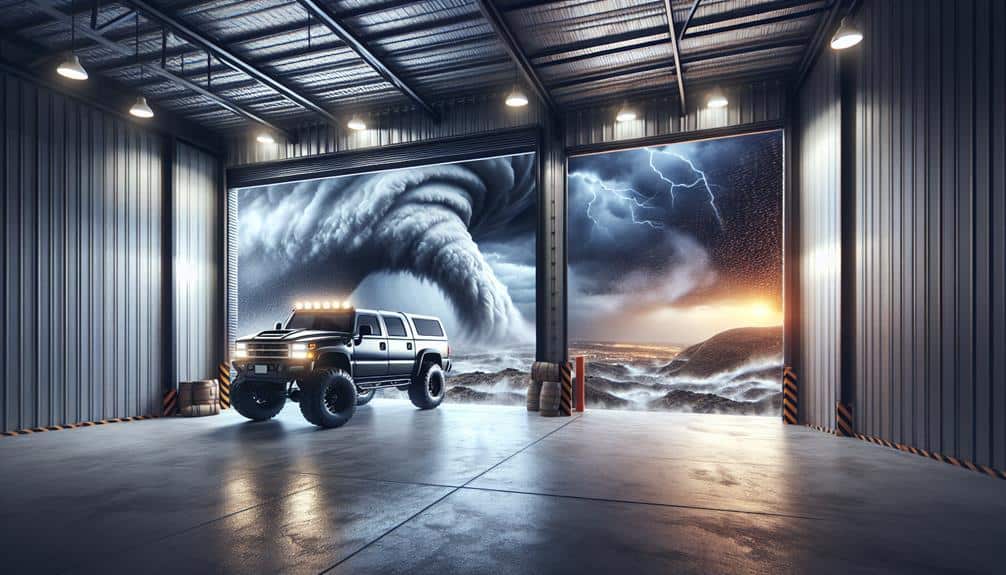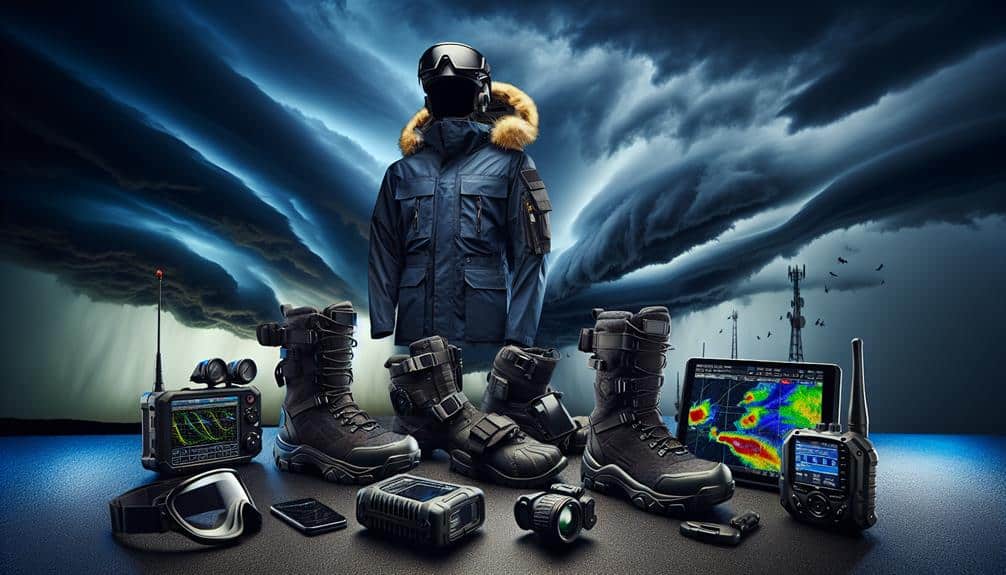To protect our vehicles during storm chasing, we depend on several specific strategies. We start by evaluating weather conditions with Doppler radar and satellite imagery to grasp storm paths. In-the-moment tracking via GPS and instant alerts aid us in adjusting routes quickly. Outfitting our cars with reinforced windows, skid plates, and water-repelling coatings ensures physical defense. Maintaining a calculated distance from storm centers and identifying emergency shelters are essential for safety. Finally, securing vehicles in garages or using outdoor shelters reduces storm damage effectively. Stick with us to uncover the details of each tactic for the best vehicle protection.
Key Points
- Equip vehicles with reinforced windows, windshield coverings, and protective guards for headlights and taillights.
- Utilize real-time GPS tracking and storm alerts to adjust routes promptly and maintain safe distances.
- Store vehicles in garages or use outdoor shelters to minimize storm damage.
- Apply hydrophobic coatings and use all-terrain, reinforced sidewall tires for enhanced durability.
Assess Weather Conditions
To ensure vehicle protection during storm chasing, we must first accurately assess current and forecasted weather conditions using reliable meteorological data. This begins with rigorous weather monitoring, employing tools like Doppler radar, satellite imagery, and numerical weather prediction models. These instruments provide real-time data on storm development, intensity, and trajectory, vital for making informed decisions.
Our approach to risk assessment involves evaluating this data to identify potential hazards such as hail, strong winds, and flooding. For instance, Doppler radar can detect rotation within a storm, indicating a possible tornado. By analyzing radar signatures, we can determine the storm's severity and probable impact area.
Satellite imagery offers a broader view, allowing us to track storm systems over large geographical areas and assess their evolution.
We must also consider forecast data from trusted sources like the National Weather Service. These forecasts help us anticipate changes in weather patterns and prepare accordingly. By integrating multiple data sources, we can create a thorough risk profile for each chase, enabling us to make strategic decisions that prioritize vehicle safety while maintaining our freedom to explore.
Ultimately, precise weather monitoring and thorough risk assessment are essential for safeguarding our vehicles during storm chasing adventures.
Use Real-Time Tracking
By leveraging real-time tracking technologies, we can monitor storm movements and adjust our routes to avoid hazardous conditions promptly. GPS monitoring systems provide precise location data, allowing us to track storm trajectories and anticipate potential impacts. Real-time storm alerts keep us informed of sudden changes in weather conditions, ensuring we're always one step ahead of the storm.
Effective use of real-time tracking involves several key strategies:
- GPS Monitoring: Utilizing advanced GPS systems, we can obtain accurate and up-to-date information about our current location and the storm's path. This helps in making informed decisions about when to move and when to stay put.
- Storm Alerts: Subscribing to reliable storm alert services ensures we receive immediate notifications about severe weather developments. These alerts are essential for adjusting our plans in real-time and maintaining safety.
- Location Sharing with Emergency Contacts: Sharing our real-time location with trusted emergency contacts provides an additional layer of security. In case of an emergency, they can track our movements and coordinate rescue efforts if necessary.
Equip With Protective Gear
Equipping our vehicle with protective gear is essential to lessen damage from flying debris and extreme weather conditions during storm chasing. First, we should install reinforced windows and windshield coverings. Polycarbonate layers can withstand impacts up to 200 times better than glass, greatly reducing the risk of shattering.
Proper gear like aluminum or steel guards for the headlights and taillights can prevent costly repairs and maintain our visibility during the chase.
Next, we need to focus on the vehicle's body. Adding skid plates and splash guards protects the undercarriage from debris and water damage. These components are vital for maintaining the integrity of the vehicle's mechanical parts.
Additionally, applying a hydrophobic coating to the exterior helps repel water, reducing the risk of corrosion over time.
Safety precautions extend to the vehicle's tires. All-terrain, reinforced sidewall tires offer superior grip and durability on unpredictable surfaces. Data indicates that these tires reduce the likelihood of blowouts by 30%, an important factor when dealing with storm-affected areas.
Lastly, securing a roof rack with aerodynamic design minimizes wind resistance and provides a sturdy structure for mounting essential equipment without compromising the vehicle's stability.
Proper gear and safety precautions guarantee our vehicle remains resilient under extreme conditions.
Maintain Safe Distance
Maintaining a safe distance from the storm's core is vital for minimizing the risk of vehicle damage and securing our safety during the chase. By keeping a calculated distance, we protect our equipment and provide ourselves with a buffer to react to sudden changes in the storm's path.
To achieve this, we should follow these key strategies:
1. Utilize Real-Time Data:
Leveraging radar and satellite data allows us to track the storm's movement accurately. By constantly updating our position relative to the storm, we can maintain a safe distance and avoid the most severe conditions.
2. Pre-Identify Emergency Shelters:
Before heading out, we should map out potential emergency shelter locations. These shelters could include sturdy buildings or overpasses that provide protection if the storm changes direction unexpectedly.
3. Ensure Reliable Communication Devices:
Maintaining open lines of communication is essential. Using reliable communication devices such as two-way radios and mobile phones ensures we can stay in touch with other chasers and receive timely updates about the storm's progression.
Secure Vehicle Storage

Securing our vehicle in a strong, sheltered location greatly reduces the risk of damage during storm chasing. Data indicates that vehicles stored in garage storage experience 70% fewer instances of storm damage.
When a garage isn't available, an outdoor shelter can provide substantial protection. These structures, if anchored properly, can shield our vehicle from hail, high winds, and flying debris.
Our approach should include employing car covers as a supplementary measure. High-quality, weatherproof car covers can shield vehicle surfaces from minor debris and precipitation. While not a replacement for garage storage or outdoor shelters, car covers can add an extra layer of defense.
In addition to physical barriers, weatherproofing techniques such as sealing windows and doors can prevent water ingress. Research shows that vehicles with properly sealed windows have a 50% lower chance of interior water damage during severe weather.
To maximize our safety and vehicle integrity, we should combine these methods. By utilizing garage storage, or when unavailable, an outdoor shelter, and integrating car covers and other weatherproofing techniques, we can effectively minimize potential damage, ensuring our storm-chasing adventures remain as safe and enjoyable as possible.
Frequently Asked Questions
How Should I Prepare My Vehicle for Long-Duration Storm Chasing Trips?
We should guarantee rigorous vehicle maintenance and safety precautions before setting out. Constant weather monitoring and precise route planning are essential. This preparation guarantees freedom to adapt quickly to changing conditions, maximizing our safety and efficiency in storm chasing.
What Are the Insurance Implications of Storm Chasing With My Vehicle?
What's the impact on insurance coverage when storm chasing? We need to review our policies to understand liability risks. Storm chasing can affect both all-inclusive and collision coverage, so we must make sure we're adequately protected against potential damages.
Are There Specific Vehicle Types Better Suited for Storm Chasing?
We've found that vehicles with high durability and off-road capabilities, like SUVs and trucks, are best suited for storm chasing. Data shows they handle rough terrains and severe weather conditions more effectively, offering us greater freedom and safety.
How Do I Handle Vehicle Repairs During a Storm Chasing Expedition?
When handling vehicle repairs during a storm chasing expedition, we minimize repair costs by ensuring insurance coverage and taking safety precautions. For emergency repairs, we carry essential tools and parts, prioritizing our safety and efficiency.
What Emergency Supplies Should I Carry in My Vehicle While Storm Chasing?
Did you know 80% of storm chasers report needing emergency supplies? We should carry emergency food, water, a first aid kit, and tools to guarantee our safety and preparedness while chasing these powerful, unpredictable forces of nature.


